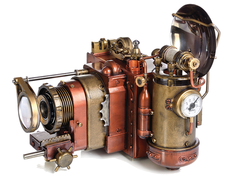Continuous shooting for detailed photography
On the Table

© Lead Image © 3355m, 123RF.com
The combination of a web camera, Raspberry Pi, and simple software facilitates miniature tabletop photography.
Photographers often rely on tabletop photography to take product photos for advertising campaigns or illustrations for magazines. Even a digital camera or smartphone is up to this task, but you have good reasons to look into USB and web cameras, as well. Armed with a 4K USB camera, a focus distance of 3cm, an integrated zoom function, and a Raspberry Pi with USB 3.0 ports, tabletop photographers can embark on their mission.
Raspberry Pi Cameras
Currently, the Raspberry Pi Foundation officially supports the V2 camera module (also available in the NoIR variant) and the Pi High Quality (Pi HQ) camera. The V2 module was introduced as the successor to the V1 module in 2016. The predecessor was based on an OmniVision 5647 sensor with a resolution of 5 megapixels (Mpx). In contrast, a Sony IMX219 sensor with 8Mpx is used in the V2 camera [1]. In contrast to the regular module, the NoIR camera lacks an infrared filter but otherwise has the same features [2].
The cameras have a fixed focus starting at a distance of about 70cm to the subject and with a fixed focal length. They are connected to the computer with a ribbon cable via the camera serial interface (CSI). The multimedia abstraction layer (MMAL) and Video4Linux (V4L) APIs are then used for access. You can control the cameras directly with console commands, and you have an extensive Python library for camera control with the picamera package [3].
[...]
Buy this article as PDF
(incl. VAT)
Buy Linux Magazine
Subscribe to our Linux Newsletters
Find Linux and Open Source Jobs
Subscribe to our ADMIN Newsletters
Support Our Work
Linux Magazine content is made possible with support from readers like you. Please consider contributing when you’ve found an article to be beneficial.

News
-
Parrot OS Switches to KDE Plasma Desktop
Yet another distro is making the move to the KDE Plasma desktop.
-
TUXEDO Announces Gemini 17
TUXEDO Computers has released the fourth generation of its Gemini laptop with plenty of updates.
-
Two New Distros Adopt Enlightenment
MX Moksha and AV Linux 25 join ranks with Bodhi Linux and embrace the Enlightenment desktop.
-
Solus Linux 4.8 Removes Python 2
Solus Linux 4.8 has been released with the latest Linux kernel, updated desktops, and a key removal.
-
Zorin OS 18 Hits over a Million Downloads
If you doubt Linux isn't gaining popularity, you only have to look at Zorin OS's download numbers.
-
TUXEDO Computers Scraps Snapdragon X1E-Based Laptop
Due to issues with a Snapdragon CPU, TUXEDO Computers has cancelled its plans to release a laptop based on this elite hardware.
-
Debian Unleashes Debian Libre Live
Debian Libre Live keeps your machine free of proprietary software.
-
Valve Announces Pending Release of Steam Machine
Shout it to the heavens: Steam Machine, powered by Linux, is set to arrive in 2026.
-
Happy Birthday, ADMIN Magazine!
ADMIN is celebrating its 15th anniversary with issue #90.
-
Another Linux Malware Discovered
Russian hackers use Hyper-V to hide malware within Linux virtual machines.

